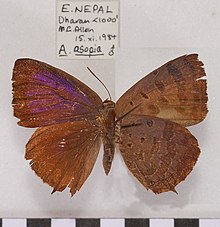| Arhopala asopia | |
|---|---|

| |
| Arhopala asopia male | |
|
Scientific classification
| |
| Domain: | Eukaryota |
| Kingdom: | Animalia |
| Phylum: | Arthropoda |
| Class: | Insecta |
| Order: | Lepidoptera |
| Family: | Lycaenidae |
| Genus: | Arhopala |
| Species: | A. asopia
|
| Binomial name | |
| Arhopala asopia | |
Arhopala asopia, the plain tailless oakblue, is a butterfly in the family Lycaenidae. It was described by William Chapman Hewitson in 1869. It is found in the Indomalayan realm (Manipur, Assam, Burma, Thailand, and Laos). [2]
Beneath lighter yellowish) brown otherwise very similar to [related species], particularly in the marking; the most conspicuous is the very much lighter, whitish spot in the subanal region of the forewing. Distinctly separated above in the male by being quite light violettish-blue with a blackish-brown marginal band of more than 3 mm width. [3]
- ^ Hewitson, W.C. 1863–1878. Illustrations of diurnal Lepidoptera, Lycaenidae. London, van Vorst, x + 229 pp, 107 pls.
- ^ Seitz, A., 1912-1927. Die Indo-Australien Tagfalter Grossschmetterlinge Erde 9
-
^ Seitz , A. Band 9: Abt. 2, Die exotischen Großschmetterlinge, Die indo-australischen Tagfalter, 1927, 1197 Seiten 177 Tafeln
 This article incorporates text from this source, which is in the
public domain.
This article incorporates text from this source, which is in the
public domain.
- Arhopala Boisduval, 1832 at Markku Savela's Lepidoptera and Some Other Life Forms. Retrieved June 3, 2017.
| Arhopala asopia | |
|---|---|

| |
| Arhopala asopia male | |
|
Scientific classification
| |
| Domain: | Eukaryota |
| Kingdom: | Animalia |
| Phylum: | Arthropoda |
| Class: | Insecta |
| Order: | Lepidoptera |
| Family: | Lycaenidae |
| Genus: | Arhopala |
| Species: | A. asopia
|
| Binomial name | |
| Arhopala asopia | |
Arhopala asopia, the plain tailless oakblue, is a butterfly in the family Lycaenidae. It was described by William Chapman Hewitson in 1869. It is found in the Indomalayan realm (Manipur, Assam, Burma, Thailand, and Laos). [2]
Beneath lighter yellowish) brown otherwise very similar to [related species], particularly in the marking; the most conspicuous is the very much lighter, whitish spot in the subanal region of the forewing. Distinctly separated above in the male by being quite light violettish-blue with a blackish-brown marginal band of more than 3 mm width. [3]
- ^ Hewitson, W.C. 1863–1878. Illustrations of diurnal Lepidoptera, Lycaenidae. London, van Vorst, x + 229 pp, 107 pls.
- ^ Seitz, A., 1912-1927. Die Indo-Australien Tagfalter Grossschmetterlinge Erde 9
-
^ Seitz , A. Band 9: Abt. 2, Die exotischen Großschmetterlinge, Die indo-australischen Tagfalter, 1927, 1197 Seiten 177 Tafeln
 This article incorporates text from this source, which is in the
public domain.
This article incorporates text from this source, which is in the
public domain.
- Arhopala Boisduval, 1832 at Markku Savela's Lepidoptera and Some Other Life Forms. Retrieved June 3, 2017.